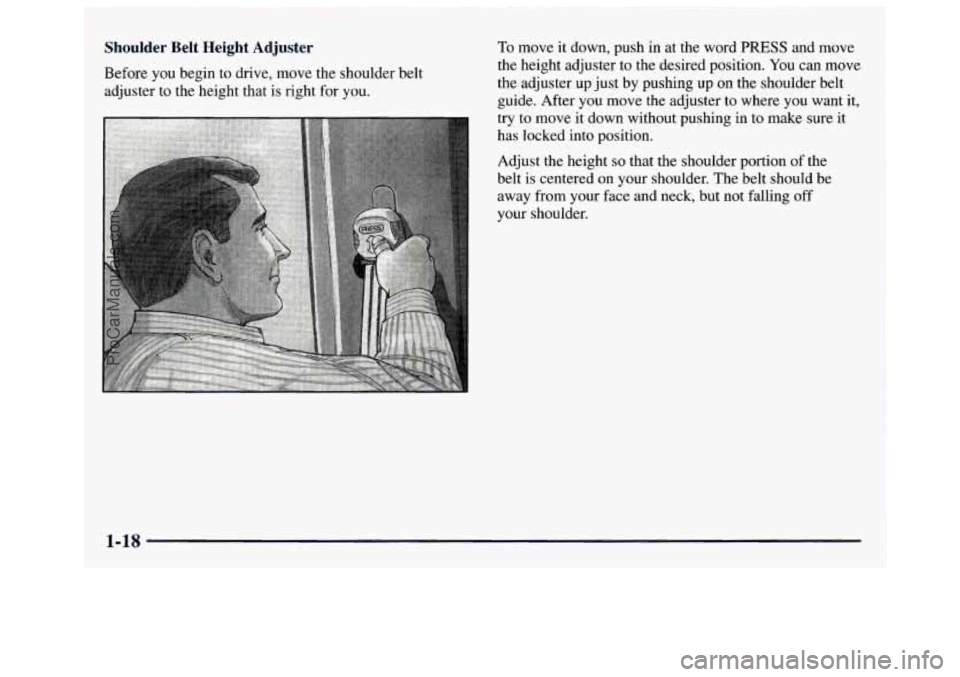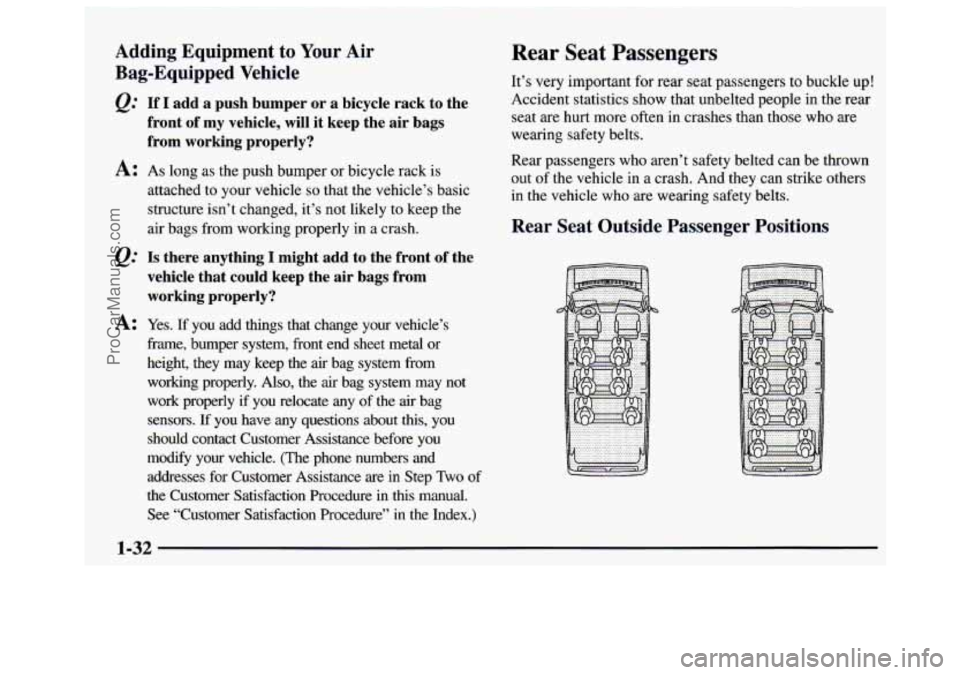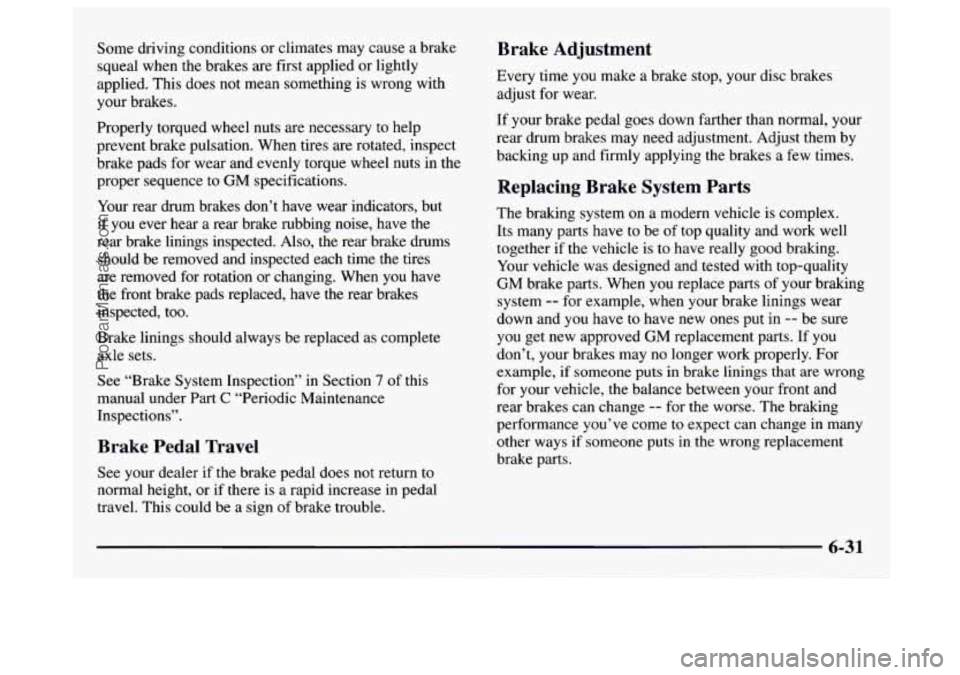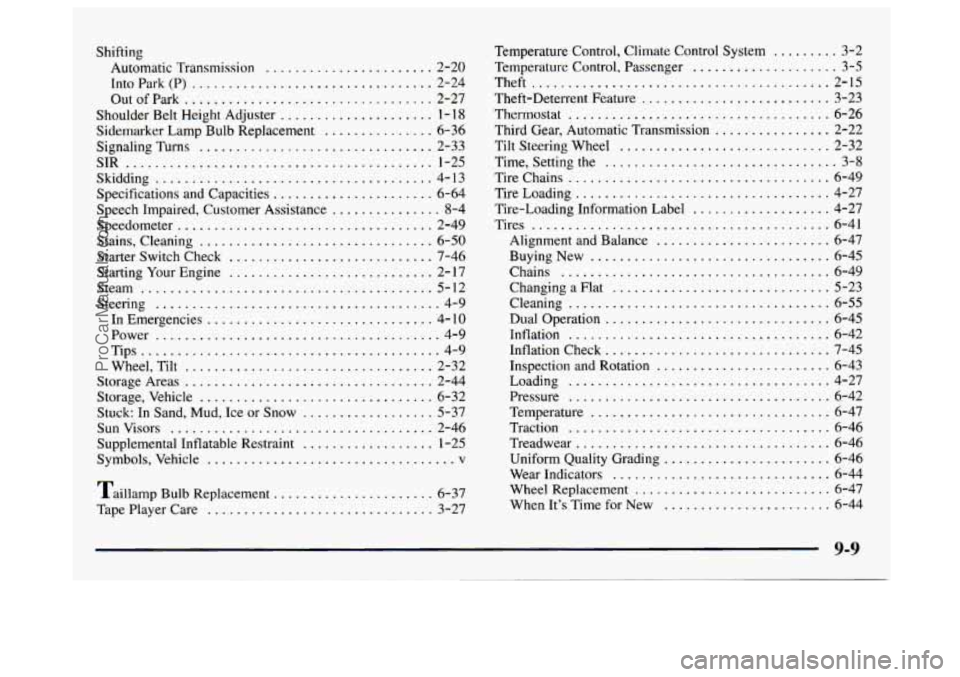height GMC SAVANA 1997 Owners Manual
[x] Cancel search | Manufacturer: GMC, Model Year: 1997, Model line: SAVANA, Model: GMC SAVANA 1997Pages: 388, PDF Size: 20.17 MB
Page 26 of 388

Shoulder Belt Height Adjuster
Before you begin to drive, move the shoulder belt
adjuster to the height that is right for
you.
To move it down, push in at the word PRESS and move
the height adjuster to the desired position. You can move
the adjuster up just by pushing up on the shoulder belt
guide. After you move the adjuster to where you want
it,
try to move it down without pushing in to make sure it
has locked into position.
Adjust the height
so that the shoulder portion of the
belt is centered on your shoulder. The belt should be
away from your face and neck, but not falling
off
your shoulder.
1-18
ProCarManuals.com
Page 40 of 388

Adding Equipment to Your Air
Bag-Equipped Vehicle
If I add a push bumper or a bicycle rack to the
front of my vehicle, will it keep the air bags
from working properly?
A: As long as the push bumper or bicycle rack is
attached to your vehicle
so that the vehicle’s basic
structure isn’t changed, it’s not likely
to keep the
air bags from working properly in
a crash.
Is there anything I might add to the front of the
vehicle that could keep the air bags from
working properly?
A: Yes. If you add things that change your vehicle’s
frame, bumper system, front end sheet metal or
height, they may keep the
air bag system from
working properly. Also, the air bag system may not
work properly if you relocate any of the air bag sensors.
If you have any questions about this, you
should contact Customer Assistance before you
modify your vehicle. (The phone numbers and
addresses for Customer Assistance are in Step
Two of
the Customer Satisfaction Procedure in this
manual.
See “Customer Satisfaction Procedure” in the Index.)
Rear Seat Passengers
It’s very important for rear seat passengers to buckle up!
Accident statistics show that unbelted people in the rear
seat
are hurt more often in crashes than those who are
wearing safety belts.
Rear passengers who aren’t safety belted can be thrown
out
of the vehicle in a crash. And they can strike others
in the vehicle who are wearing safety belts.
Rear Seat Outside Passenger Positions
ProCarManuals.com
Page 265 of 388

Some driving conditions or climates may cause a brake
squeal when the brakes are first applied or lightly
applied. This does not mean something is wrong with
your brakes.
Properly torqued wheel nuts are necessary to help
prevent brake pulsation. When tires are rotated, inspect
brake pads for wear and evenly torque wheel nuts in the
proper sequence to
GM specifications.
Your rear drum brakes don’t have wear indicators, but
if you ever hear a rear brake rubbing noise, have the
rear brake linings inspected. Also, the rear brake drums should be removed and inspected each time the tires
are removed for rotation or changing. When you have
the front brake pads replaced, have the rear brakes
inspected, too.
Brake linings should always be replaced as complete
axle sets.
See “Brake System Inspection” in Section
7 of this
manual under Part
C “Periodic Maintenance
Inspections”.
Brake Pedal Travel
See your dealer if the brake pedal does not return to
normal height, or
if there is a rapid increase in pedal
travel. This could be a sign of brake trouble.
Brake Adjustment
Every time you make a brake stop, your disc brakes
adjust for wear.
If your brake pedal goes down farther than normal, your
rear drum brakes may need adjustment. Adjust them by
backing up and firmly applying the brakes a few times.
Replacing Brake System Parts
The braking system on a modern vehicle is complex.
Its many parts have to be of top quality and work well
together if the vehicle is to have really good braking.
Your vehicle was designed and tested with top-quality
GM brake parts. When you replace parts of your braking
system
-- for example, when your brake linings wear
down and you have to have new ones put in
-- be sure
you get new approved GM replacement parts. If you
don’t, your brakes may no longer work properly. For
example,
if someone puts in brake linings that are wrong
for your vehicle, the balance between your front and
rear brakes can change
-- for the worse. The braking
performance you’ve come to expect can change in many
other ways if someone puts in the wrong replacement
brake parts.
6-31
ProCarManuals.com
Page 282 of 388

L dT’^Y:
Using the wrong replacement wheels, wheel
bolts or wheel nuts on your vehicle can be
dangerous.
It could affect the braking and
handling
of your vehicle, make your tires lose
air and make you lose control. You could have a
collision in which you or others could be injured.
Always use the correct wheel, wheel bolts and
wheel nuts for replacement.
NOTICE:
The wrong wheel can also cause problems with
bearing life, brake cooling, speedometer or
odometer calibration, headlamp aim, bumper
height, vehicle ground clearance and tire or tire
chain clearance to the body and chassis.
Whenever a wheel, wheel bolt or wheel nut is replaced
on a dual wheel setup, check the wheel nut torque after
100, 1,000 and 6,000 miles (160,l 600 and
10 000 km)
of driving. For proper torque, see “Wheel Nut Torque”
in the Index.
See “Changing a Flat Tire” in the Index for
more information.
Used Replacement WP-?ls
A CAUTIP’
Putting a used wheel on your vehicle is
dangerous. You can’t know how it’s been used or
how far it’s been driven.
It could fail suddenly
and cause an accident.
If you have to replace a
wheel, use
a new GM original equipment wheel.
6-48
ProCarManuals.com
Page 383 of 388

Shifting Automatic Transmission
....................... 2-20
Into Park
(P) ................................. 2-24
OutofPark
.................................. 2-27
Shoulder Belt Height Adjuster
..................... 1 - 18
Sidemarker Lamp Bulb Replacement
............... 6-36
Signaling Turns
................................ 2-33
SIR .......................................... 1-25
Skidding
...................................... 4-13
Specifications and Capacities
...................... 6-64
Speech Impaired. Customer Assistance
............... 8-4
Speedometer
................................... 2-49
Stains. Cleaning
................................ 6-50
Starter Switch Check
............................ 7-46
Starting Your Engine
............................ 2- 17
Steam
........................................ 5-12
Steering
....................................... 4-9
In Emergencies
............................... 4- 10
Power ....................................... 4-9
Tips
......................................... 4-9
Wheel. Tilt
.................................. 2-32
StorageAreas
.................................. 2-44
Storage, Vehicle
................................ 6-32
Stuck: In Sand, Mud. Ice or Snow
.................. 5-37
SunVisors
.................................... 2-46
Supplemental Inflatable Restraint
.................. 1-25
Symbols, Vehicle .................................. v
Taillamp Bulb Replacement ...................... 6-37
TapePlayerCare
............................... 3-27 Temperature Control.
Climate Control System
......... 3-2
Temperature Control. Passenger .................... 3-5
Theft
......................................... 2-15
Theft-Deterrent Feature
.......................... 3-23
Thermostat
.................................... 6-26
Third Gear. Automatic Transmission
................ 2-22
Tilt Steering Wheel
............................. 2-32
Time. Setting the
................................ 3-8
Tire Chains
.................................... 6-49
TireLoading
................................... 4-27
'Tire-Loading Information Label
................... 4-27
Tires
......................................... 6-41
Alignment and Balance
........................ 6-47
Buying New
................................. 6-45
Chains
..................................... 6-49
Changing
a Flat .............................. 5-23
Dual Operation ............................... 6-45
Inflation
.................................... 6-42
Inflation Check
............................... 7-45
Inspection and Rotation
........................ 6-43
Loading
.................................... 4-27
Pressure
.................................... 6-42
Temperature
................................. 6-47
Traction
.................................... 6-46
Treadwear
................................... 6-46
Uniform Quality Grading
....................... 6-46
Wear Indicators
.............................. 6-44
Wheel Replacement
........................... 6-47
When It's Time for New
....................... 6-44
Cleaning
.................................... 6-55
ProCarManuals.com